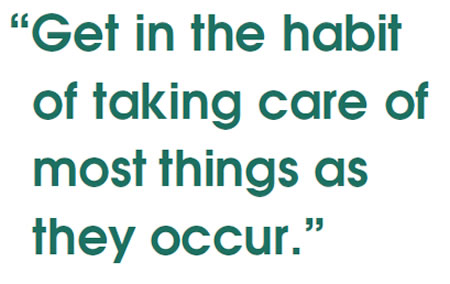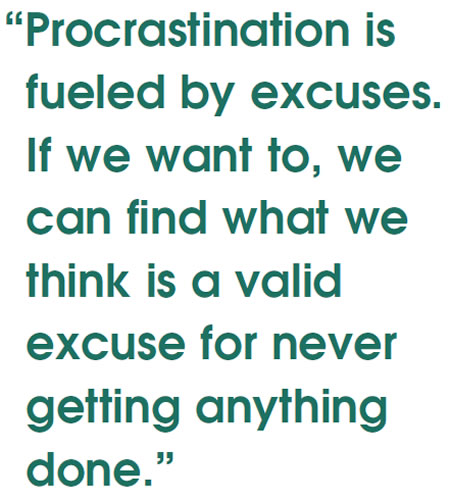
It’s Your Business
- Author: Terry Greenhut, Management Editor
I wish I could remember the name of the speaker who first posed the question that so dramatically changed my life so I could give him credit, but I can’t. I can remember only the question. It was a simple one: “When would be a good day to start?” Every time someone in the audience would agree to change a process, a procedure or an attitude toward life or business, the speaker would first ask, “Just exactly how and what do you think it will take to accomplish that?” Once they went into agreement as to how the task should be accomplished, he would ask, “And when would be a good day to start?”
Obviously, the speaker was looking for a specific date and time when this change, whatever it was, would be instituted. Without that commitment there was always a good chance that whatever it was would never happen.
When people attend seminars, listen to tapes or read informative books, they tend to get all jazzed up about fixing the problems with their businesses. Unfortunately, if they don’t take action to begin the change soon after the initial impact of recognizing the need and devising a plan to make it happen, the intensity can dwindle quickly or other factors can creep in and stop a good plan dead in its tracks.

“Strike while the iron is hot” is an appropriate phrase, and it’s hot when you first hear or think of it. While the plan is fresh, when you can see the goal, when you aren’t sidetracked by everything else that would get in the way of accomplishing it, that’s the day to start. Now is always a good time to do anything.
The things we need to do most and want to do least are prime examples of why we procrastinate. First, if we can’t develop a clear picture of how we can accomplish a task, we may never start it. That’s how some of us think. We have to be able to picture in our mind’s eye every aspect of the project, including its eventual outcome, or we can’t work up the enthusiasm to begin.
There are two great examples of this in the transmission- and auto-repair industries. One is initiating a truly good, workable and sustainable outside-sales program; the other is starting and maintaining a strong follow-up effort that keeps existing customers coming back. Although everyone seems to know they need to do both, most have a problem committing to start or continue them.
Procrastination is fueled by excuses. If we want to, we can find what we think is a valid excuse for never getting anything done. In outside sales, for example, there are lots of great reasons for never starting or for giving up. Do some of these sound familiar?

“I can’t find the right person to sell for me.”
My answer to that one is, “How hard did you look?”
There are only several billion people on this planet. Surely you could have found one. And if you couldn’t, what about you? If you really think outside sales is so important and you can’t find anyone to do it, why aren’t you out there knocking on doors yourself? Is it because you don’t know how? You can learn. Do you think it’s beneath you to do that kind of work? It isn’t beneath anyone who is trying to build any kind of a business. Is it because you lack confidence in the shop’s ability to perform the work? You may need a training program or better technicians who can give you confidence in their abilities. Are you afraid you might actually land a big account and have to buy more equipment, hire more people or have to float receivables?
You see, any excuse can stop you dead in your tracks – if you let it. The key is to set your mind to believe that whatever the task, it is the most-important, can’t-live-without-it task that must be done, no matter what. A good way to do that might be to picture the first day you were in business in your brand-new shop. If you were anything like me you were standing there looking at all that shiny new equipment and a serious lack of vehicles to work on – like none at all. It would have dawned on you pretty quickly, as it did on me, that if I didn’t hit the streets and get some work in I’d be gone within a few months. So I dropped everything else I was doing and went out looking for business. I set goals for how many doors I would knock on in a day and how many of the people I saw would say yes, they would give me a try. If they didn’t send work right away I went back to see them over and over again until they either agreed or threw me out.
Did I have to push myself to get out there and sell? Sure, I did, because I was shy, I didn’t know how to sell at the time, I didn’t even have a crew in place yet so I didn’t know whether I could deliver what I promised, but I knew I would kill myself trying to. I didn’t let anything get in my way. You probably didn’t, either, in the beginning, but what about now?
When you get or are given a good idea, one that could really improve your business, how quick are you to implement it? Many business owners develop “analysis paralysis” – they over-think everything, to the point that they don’t get much done at all. Anything new or different scares them. They take up a defensive posture, trying to hold on to what they’ve got rather than building and moving forward. That’s not to say it isn’t all right to be a bit on the conservative side, but you can’t do nothing at all and expect your business to magically improve. Left to their own devices, things don’t tend to get better, only worse.
Customer follow-up used to be the toughest challenge of all and the one that most shop owners shied away from. Before computers it all had to be done by hand. Any piece of mail that went out to a customer had to be produced over and over again on an individual basis with the proper information added, such as in the case of service reminders based on customers’ needs. I knew one shop owner who had three women doing nothing but customer follow-up five days a week. Was it worth the trouble? It built the business into a multimillion-dollar operation, so you judge.
Today follow-up is easy. Computers do most of the work for us. The simple act of generating an initial repair order for a customer starts a process that can endure for many years. All you have to do to keep it going is press a couple of buttons every once in a while. As simple as that sounds, most shop owners and managers can’t get into the habit of doing it, or if they do it for a little while and don’t see it produce really exciting results they give up on it.
You may think that setting goals and beginning to accomplish them is the hard part. I think the ongoing effort is even more difficult. When an idea is new it has a lot of promise. “Maybe this will be the magic bullet. Maybe this will be the program that will make me a millionaire.” The excitement always wears off quickly, because there is no magic anything. At some point there is always the realization that “It takes many years of very hard work to become an overnight success.”
Want to set a goal for answering the telephone correctly, using a process for diagnosing and recommending proper services, launching an outside-sales or advertising campaign, marketing to previous customers or managing the shop for increased productivity? The question you need to ask yourself is, “When would be a good day to start?” Then clear the decks. Don’t let anything get in your way. Forge ahead. Be like a “bull in a china shop” once you decide to start a new project. Don’t say, “I can’t start this week because I have a technician on vacation or because someone is out sick.” Every day there will be some other reason why you can’t if you let life get in the way.
Remember that procrastinating often takes even more time than the initial task would have, because you go back to it over and over again before it gets done. Whatever it is, do it now. Get in the habit of taking care of most things as they occur. I like the idea of touching a piece of paper only one time. That means when you pick it up from your desk do whatever needs to be done with it. Don’t look at it and say, “I’ll do that later” and lay it back down. Do it now, file it away and be done with it. You’ll get a lot more accomplished and be much happier for it.

Visit www.TerryGreenhut.com.













